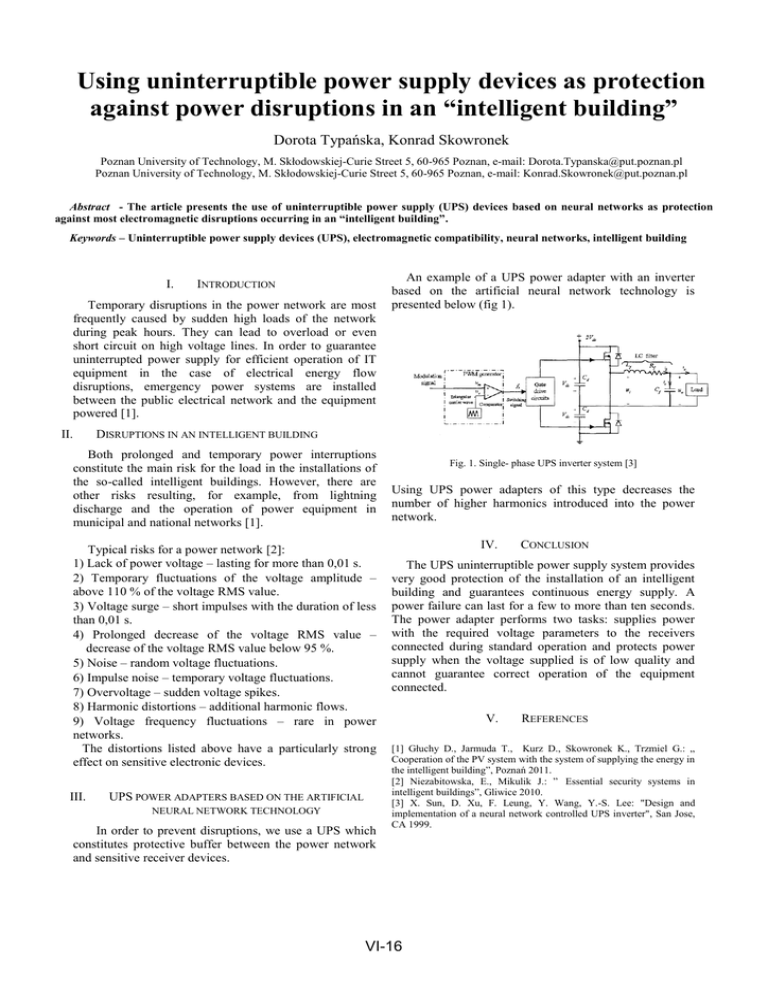Using uninterruptible power supply devices as protection against
advertisement

Using uninterruptible power supply devices as protection against power disruptions in an “intelligent building” Dorota Typańska, Konrad Skowronek Poznan University of Technology, M. Skłodowskiej-Curie Street 5, 60-965 Poznan, e-mail: Dorota.Typanska@put.poznan.pl Poznan University of Technology, M. Skłodowskiej-Curie Street 5, 60-965 Poznan, e-mail: Konrad.Skowronek@put.poznan.pl Abstract - The article presents the use of uninterruptible power supply (UPS) devices based on neural networks as protection against most electromagnetic disruptions occurring in an “intelligent building”. Keywords – Uninterruptible power supply devices (UPS), electromagnetic compatibility, neural networks, intelligent building I. INTRODUCTION Temporary disruptions in the power network are most frequently caused by sudden high loads of the network during peak hours. They can lead to overload or even short circuit on high voltage lines. In order to guarantee uninterrupted power supply for efficient operation of IT equipment in the case of electrical energy flow disruptions, emergency power systems are installed between the public electrical network and the equipment powered [1]. II. DISRUPTIONS IN AN INTELLIGENT BUILDING Both prolonged and temporary power interruptions constitute the main risk for the load in the installations of the so-called intelligent buildings. However, there are other risks resulting, for example, from lightning discharge and the operation of power equipment in municipal and national networks [1]. Typical risks for a power network [2]: 1) Lack of power voltage – lasting for more than 0,01 s. 2) Temporary fluctuations of the voltage amplitude – above 110 % of the voltage RMS value. 3) Voltage surge – short impulses with the duration of less than 0,01 s. 4) Prolonged decrease of the voltage RMS value – decrease of the voltage RMS value below 95 %. 5) Noise – random voltage fluctuations. 6) Impulse noise – temporary voltage fluctuations. 7) Overvoltage – sudden voltage spikes. 8) Harmonic distortions – additional harmonic flows. 9) Voltage frequency fluctuations – rare in power networks. The distortions listed above have a particularly strong effect on sensitive electronic devices. III. An example of a UPS power adapter with an inverter based on the artificial neural network technology is presented below (fig 1). UPS POWER ADAPTERS BASED ON THE ARTIFICIAL NEURAL NETWORK TECHNOLOGY In order to prevent disruptions, we use a UPS which constitutes protective buffer between the power network and sensitive receiver devices. Fig. 1. Single- phase UPS inverter system [3] Using UPS power adapters of this type decreases the number of higher harmonics introduced into the power network. IV. CONCLUSION The UPS uninterruptible power supply system provides very good protection of the installation of an intelligent building and guarantees continuous energy supply. A power failure can last for a few to more than ten seconds. The power adapter performs two tasks: supplies power with the required voltage parameters to the receivers connected during standard operation and protects power supply when the voltage supplied is of low quality and cannot guarantee correct operation of the equipment connected. V. REFERENCES [1] Głuchy D., Jarmuda T., Kurz D., Skowronek K., Trzmiel G.: „ Cooperation of the PV system with the system of supplying the energy in the intelligent building”, Poznań 2011. [2] Niezabitowska, E., Mikulik J.: ” Essential security systems in intelligent buildings”, Gliwice 2010. [3] X. Sun, D. Xu, F. Leung, Y. Wang, Y.-S. Lee: "Design and implementation of a neural network controlled UPS inverter", San Jose, CA 1999. VI-16



